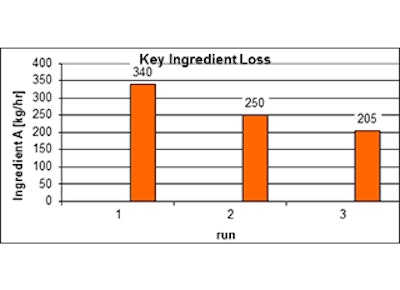
Huge gains in yield have been achieved through Lean Manufacturing, Six Sigma and Kaizen — so much that it may seem no more can be done, particularly in the waste-intensive, fast-paced food and beverage industry, where efficiency gurus seem to have wrung out every increase possible. However, we have found it is possible to produce an 18 to 25 percent improvement in yield on a repeatable basis, using an innovative combination of time-honored methods and statistical analysis. For example, through research and client engagements, we have found for one food and beverage company that an annual 0.1 percent yield improvement resulted in an additional $400,000 a year. Extending that, a 0.5 percent gain meant an additional $2 million added to their bottom line. Companies availing themselves of these powerful new processes can dramatically improve their margins.
While the concept of Continual Improvement, often referred to as Continuous Improvement, has been with us for some three decades, the three main tools, Lean Manufacturing, Six Sigma and Kaizen are generally used in various mixes and different proportions, depending on the particular task at hand. The best approach really depends on the specialized problem you’re trying to solve. Kaizen is usually about individuals or teams identifying and fixing a problem, while Lean is about improving process speed and quality by reducing waste, and Sigma seeks to optimize output, stability and accuracy. We have been looking at an approach that fine tunes the mix of Sigma and Kaizen.
Achieving These Six-Figure Improvements
| Figure 1 - Case Study: 40% Yield Improvement Saves $2 Million |
In our search for new ways to gain yield, we started by looking for a method that can spearhead a shorter problem-solving cycle. There were some areas worth exploring. We conducted a controlled study on process improvement, and with the aid of statistical analysis, evaluated several areas of process information. We identified five process parameters that have the most influence on producing waste: solids percentage, Equipment A settings, retention time in Equipment B, retention time in Equipment C and mix temperature.
The question was, in tackling these areas, are there ways to achieve more process improvements? After thorough testing, we were able to identify the parameters with the greatest influence: the heater setting (higher = less waste) and the dryer setting (faster = less waste). We found that by making the necessary adjustments — setting the heater at the highest setting, while reducing the retention time in the dryer — we were able to reduce waste by 40 percent. (See Figure 1.)
In this case study, the ingredient-loss reduction for a single plant returned over $250,000 in annualized raw-material savings — more than $2 million annual savings companywide — by applying just two of our findings. The improvements came from a shorter problem-solving cycle, deeper deployment of process-improvement skills and tools, and a wider embrace of continuous-improvement philosophy by the production team. The latter drove the sustainability of the results and ongoing improvements beyond one-off or single projects.
Less Waste Means Shortened Production Time: Bigger Improvements in Weeks, Not Months
Using a combination of known methods to identify problem areas and the technique of operator-focused problem solving, we developed a tool for rapid process improvement. This tool is ideal for projects in which there are many sources of variation in the process, and the process owner wants fast results. It can shorten the time frame from defining the problem to controlling and improving the outcome from several months to several weeks.
In addition to the shortened time frame, the process efficiency tool uncovers more opportunities for improvement through engagement of front-line operators. These team members work with processes daily, so they have intimate knowledge of what goes wrong, what goes right and how best to solve problems. At one frozen-food producer we worked with, teams were able to exceed their reduction goal for waste of a key ingredient by 15 percentage points, a total 40 percent improvement. Their practical process knowledge — combined with statistical analysis — was able to return bigger improvements in yield than statistical analysis alone.
In another case study, an organization with a large global footprint wanted to halve its scrap waste at a plant that produced food packaging. The goal was to reduce scrap waste from 5 percent to 2.5 percent — an improvement the company valued at $500,000. Initially, by focusing operator attention on the scrap problem, developing a measurement system at the source with real-time information flow and applying corrective action, the plant reduced scrap to 1.8 percent in three months — an annualized savings of $640,000. This savings will now be sustained through the company’s management, which has instituted the mindset throughout the organization that this plant will perform daily evaluations of scrap and other key metrics that affect yield.
Sustaining and Continuing the Gains Post Yield-Improvement
A common challenge in all improvement efforts, but especially in the high-volume, capital-intensive food and beverage industry, is sustaining change and continuing progress after a project ends. It’s hard work to improve yield, so it’s essential to find ways to ensure that you hold onto those gains through ongoing engagement and standardization of best practices.
To do that, it is necessary to develop management systems that arm in-house leaders with a new way of thinking and working that drives sustainability in results and ongoing improvements beyond singular projects. The goal is to create a nimble and responsive organization that exceeds performance goals and accelerates business value. A systematic, cross-functional methodology ensures that performance improvements are linked directly to strategic goals, measured daily, course corrected in real time, and sustained for the long term.
What does this boil down to? We optimized the mix between Sigma and Kaizen approaches. Essentially, this combined Sigma’s Define-Measure-Analyze-Improve-Control with Kaizen’s operator-focused approach to rapid process improvement. The resulting combination proved ideal for projects in which there are many sources of variation in the process and the process owner needs fast results. We found that this approach was able to shorten the timeframe from Define to Control from several months to several weeks.
In addition to the shortened time frame, the approach combining Sigma and Kaizen uncovered more opportunities for improvement through engagement of front-line operators. These team members work with processes daily and have intimate knowledge of what goes wrong, what goes right and how best to solve problems. Their practical process knowledge — combined with statistical analysis — can return bigger improvements in yield than statistical analysis alone.
Conclusion: Get More ROI from Yield-Improvement
From a deeper deployment of process-improvement skills and tools and a wider acceptance of continuous-improvement philosophy by management and the production team, F&B companies can experience unprecedented growth in yield, while sustaining these excellent results.
Organizations that embrace these new approaches are often among the best run companies, outperforming the S&P 500, the Dow Jones Industrial Average and, most importantly, their closest competitors. They recover more quickly from downturns, and are agile enough to continually evolve for long-term growth and profitability. Companies that take action now to boost their yield-improvement systems will see a return on their investment that will more than justify the investment they make.
About the Authors
Jonathan Chong, David Beal, Michael Hatto, Doug Bonner and Beth Morrison are consultants at TBM Consulting Group. They specialize in driving improvements and sustainment at large, global consumer products companies, and can be reached respectively at [email protected], [email protected], [email protected], [email protected] and [email protected].























